The "Corporate Campaign" Strategy
Helping Labor Unions and Public Interest Groups Confront Unbridled Corporate and Political Greed since 1981
Learn More
Helping Labor Unions and Public Interest Groups Confront Unbridled Corporate and Political Greed since 1981
On Dec. 16, 1999, The New York Times reported on its front page that Transport Workers Union Local 100 had achieved "the largest annual raises received by any of New York City's public employees in a decade."
The next day, in a New York Post op-ed column, Local 100 President Willie James elaborated on the new contract: "We held firm on job security, preventing any layoffs during the contract term, and we won substantial improvements in health benefits."
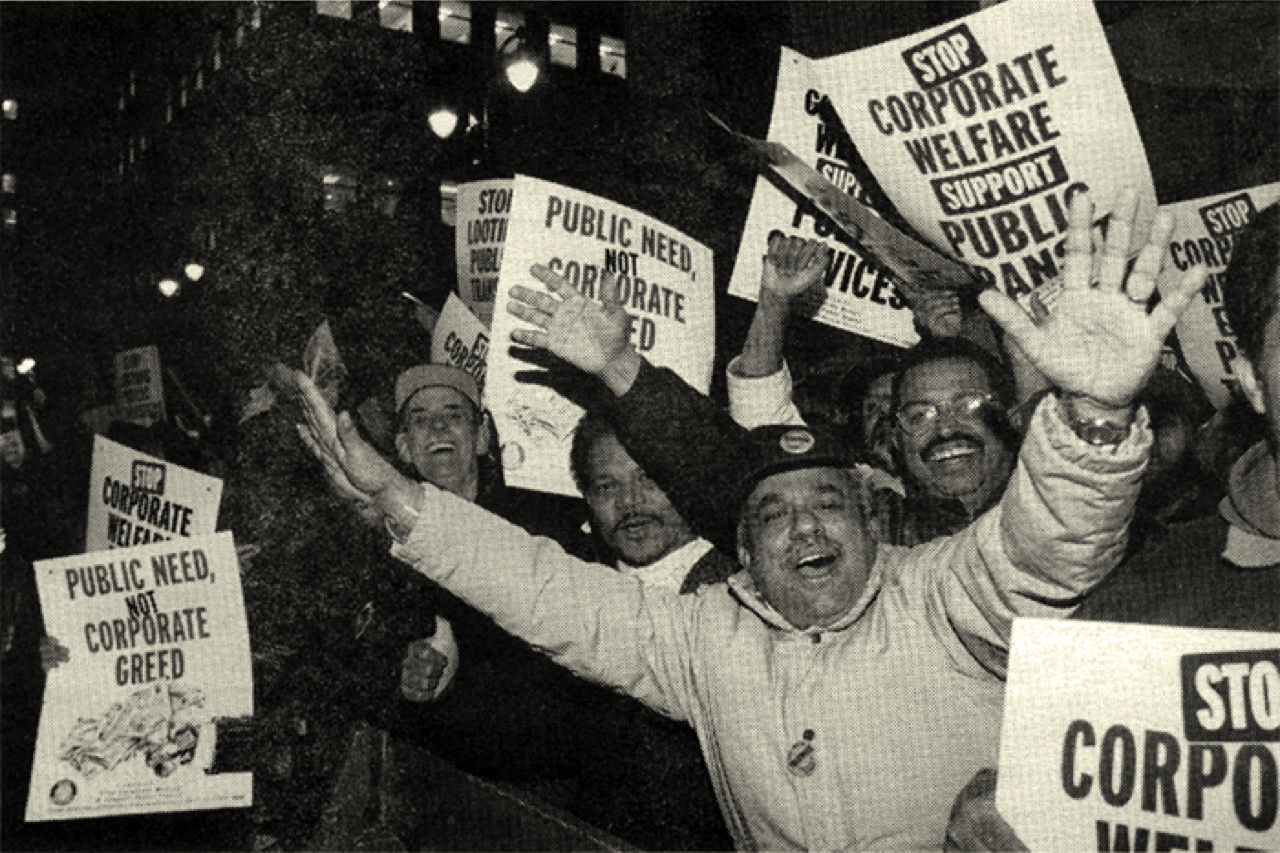
TWU Local 100 Demonstrators
(Photo from TWU Express, Transport Workers Union of America newspaper)
In the fall of 1999 prospects were pretty grim for public sector workers in New York City and upstate, particularly for the 33,000 members of TWU Local 100 who work for the Metropolitan Transit Authority (MTA) and who operate and maintain the subways and buses for the MTA. Major city and state contracts were expiring and being renegotiated under the watchful eyes of a hostile Republican Governor, George Pataki, and a ruthless, grandstanding, Republican Mayor, Rudolph Giuliani.
To make matters worse, Local 100 was suffering internal political turmoil and was thought by many to have weak leadership. The perception that the local had little chance of getting a decent contract was very troubling to municipal unions because Local 100's contract would set the pattern for bargaining in 2000 covering 300,000 city workers. Reformers in Local 100, known as New Directions, controlled about half the 46-member executive board and they pushed hard to get the top officers to agree to hire Ray Rogers and Corporate Campaign Inc. (CCI).
Rogers has always maintained that public sector struggles for fair contracts are really fights against entrenched private sector interests and unbridled corporate and financial greed. To win the really tough battles, public sector unions, he points out, must understand how to analyze, divide, weaken and dismantle the power of the Big Business Lobby, i.e,, the intertwined corporate/financial/political interests, leading the assault against them. They must then employ a sophisticated divide-and-conquer strategy directed squarely at those politicians and targeted business leaders, corporations and financial institutions that promote a greedy, anti-union agenda.
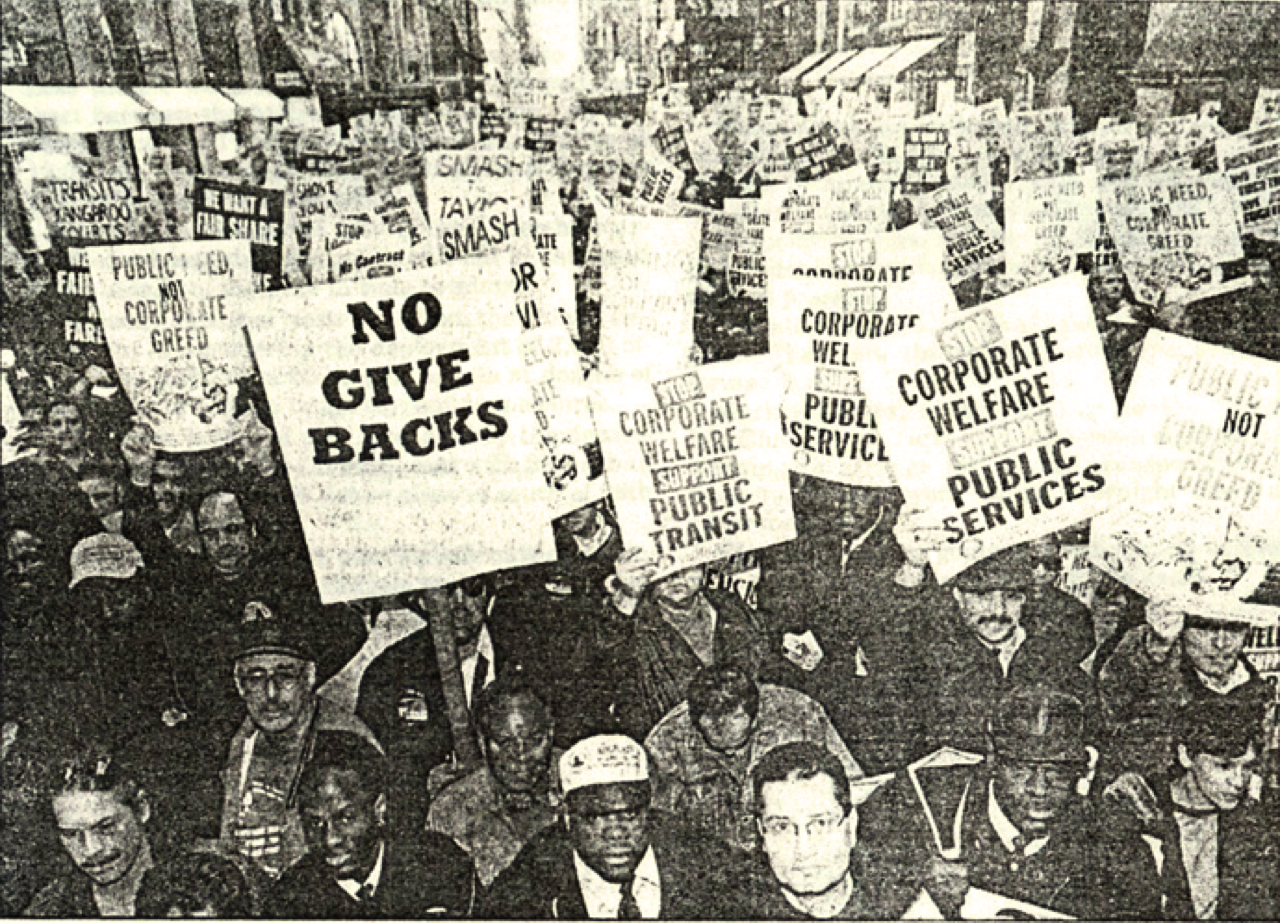
TWU Local 100 Demonstrators
(James Keivom photo in Newsday)
On October 5, 1999, Local 100 President Willie James issued a press release stating that the union had hired Corporate Campaign in August to help "mount an aggressive effort to build public support for Local 100's fight for a fair and just contract. The New York Times and the Daily News ran articles October 6, 1999. The Times article was entitled, "Fliers From Transit Union Draw on Class Distinctions: Blame 'Fat Cats' for Cuts in Public Services" and stated: "Willie James, president of Local 100 of the Transit (sic) Workers Union, said his union hired a well-known public relations consultant, Ray Rogers, to turn p the heat on the Metropolitan Transportation Authority, and on the Mayor and the Governor, who have a large say in its operations."
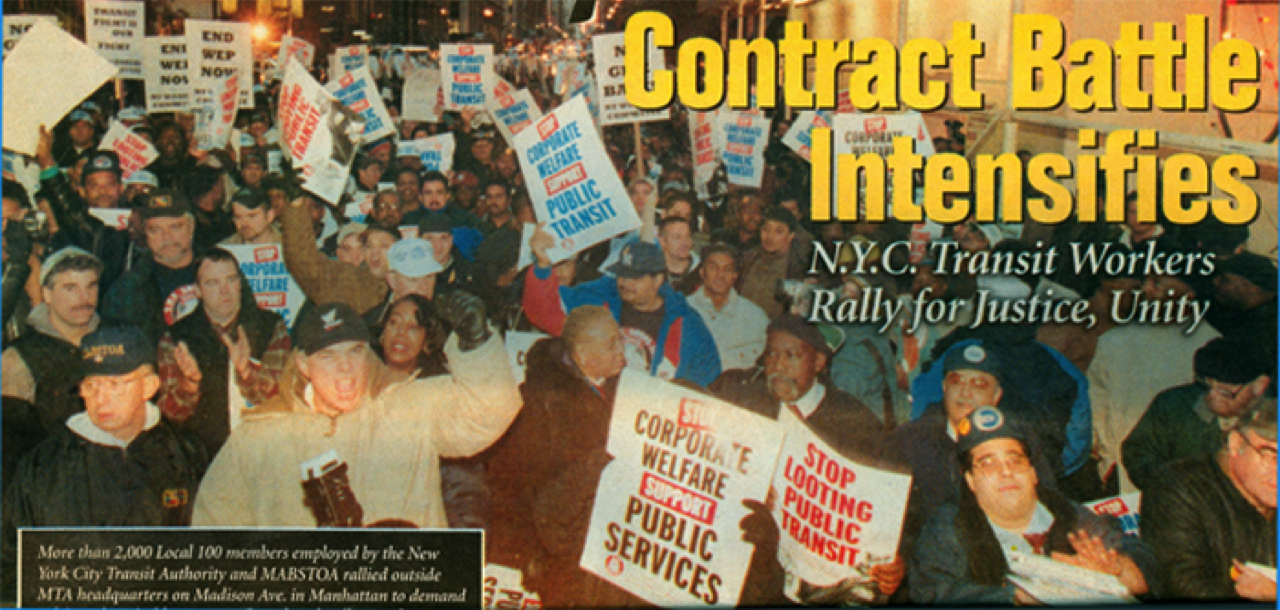
Photo from TWU Express, Transport Workers Union of America newspaper
An article in the Daily News entitled "Transit union hires corporation buster" (10/6/99), stated:
"'We went with Ray,' said Tom Cassano, an aide to James. 'He offered us a more corporate-targeted campaign. He will also help us raise more funds from other unions.'"
CCI, James said, would spearhead efforts "to reach out to other unions, community groups, religious organizations, political leaders, transit riders and the general public" and would help the union "maximize the involvement of the union's officers, staff, members and their families in one of the toughest and most important battles in our history." He then announced that the union was ready to distribute one million copies of a four-page brochure written by CCI staffer Joe Pilati and designed by CCI graphic designer Lauren Draper. Produced in English and Spanish, it told the reader: "While you swipe your card, others are swiping billions and public transit suffers!" Rogers persuaded James to establish a ten-member committee (five members from each of two warring political factions) to work with each other and CCI to distribute the brochures.
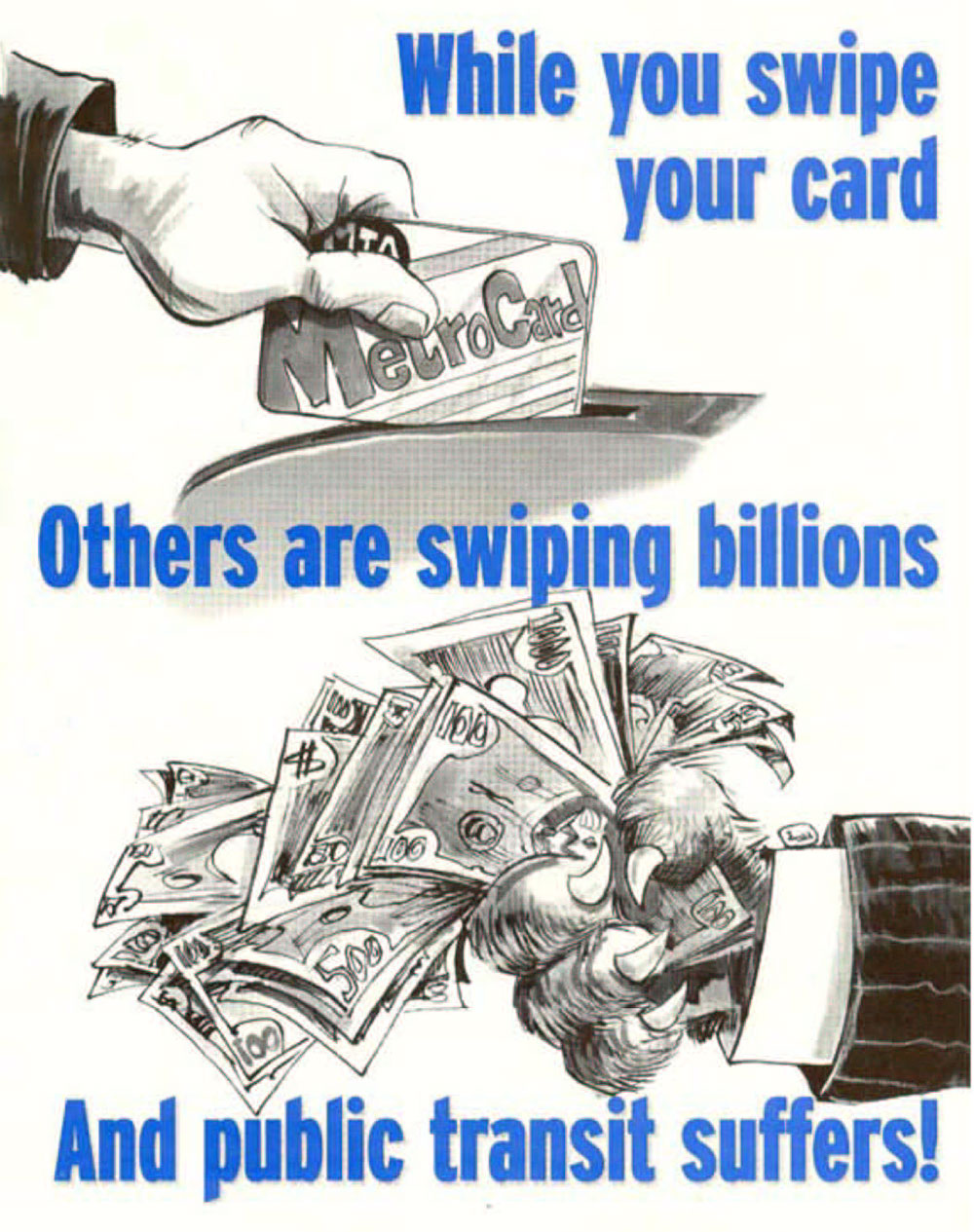
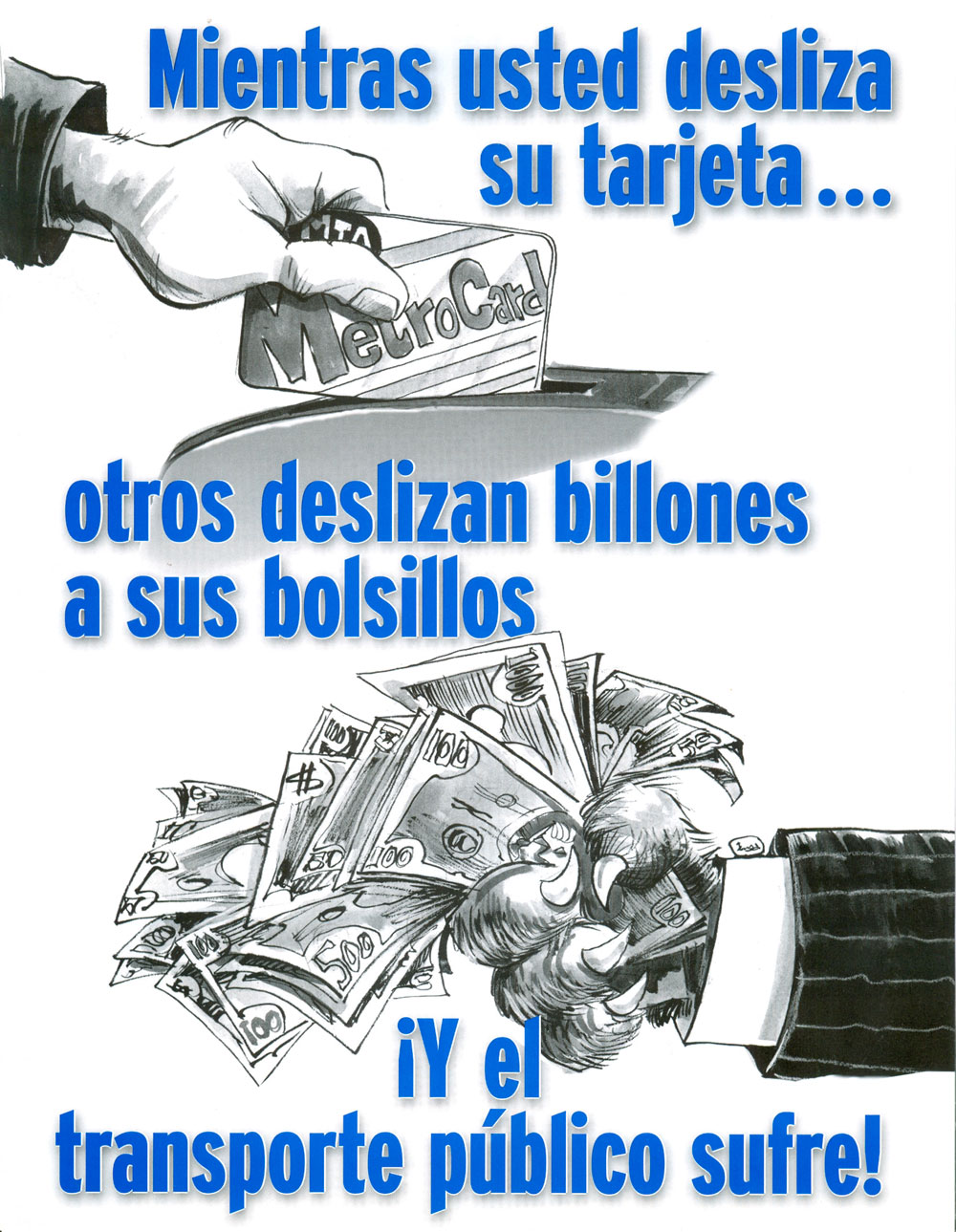
Rogers simultaneously issued a statement that said in part: "This campaign has national implications because it will expose the fraud frequently called 'economic development,' which is more aptly termed 'corporate welfare.' It will show how billions of dollars that are now wasted on subsidies, tax breaks and other giveaways to wealthy corporations should instead be applied to improving public services. The disgraceful spectacle of government at all levels helping the rich to get richer — while depriving the rest of us of critical public services — must be stopped.
"It would be foolish to underestimate the forces aligned against us in this struggle. When the union bargains with the MTA, it is also negotiating with the Giuliani and Pataki administrations and their Big Business allies, whose ultimate goal is to privatize public services, downsize the public sector workforce and wring maximum concessions from whoever is left…"
The "When You Swipe" brochure served many strategic purposes. It became a highly effective organizational, educational and public relations tool. It made serious points in a humorous way, put a friendly face on the union and advocated funding for public transit. At the same time, it placed the Big Business Lobby and its political allies, especially the governor and the mayor, on the defensive. Within a couple of weeks, half a million brochures were handed out by teams of transit employees to riders and the public. Copies of the brochure accompanied by a letter or press release were sent or delivered to every city council member, borough president, state legislator and media outlet from The New York Times to the many ethnic, community and labor union newspapers. Soon the mayor and governor were on the phone to union leaders demanding to know what the hell was going on?
CCI worked with the union to organize rallies and press conferences and crafted op-ed articles that appeared in the press. CCI's Joe Pilati developed a series of slogans and art concepts that CCI's graphic designer Lauren Draper turned into colorful, eye-catching, protest signs that helped win broad support while raising the ire of MTA management, corporate welfare recipients, the mayor and the governor.
On December 1, about a thousand transit workers wore signs saying "We Want a Fair Share, Not a Fair Hike," while handing out literature at scores of bus stops and subway stations. A week later, thousands of protesters demonstrated and waved signs reading: "Stop Corporate Welfare, Support Public Transit;" "Stop Corporate Welfare, Support Public Services;" "Stop Looting Public Transit," and "Public Need, Not Corporate Greed." Artwork on the latter two signs repeated images from the brochure: a furry, corporate fat cat dressed in a pin-striped suit grasping a fistful of $100 bills.
As public support for the union grew, MTA management and political leaders searched frantically for a way to turn the tide against Local 100. They figured they had found it when a group of some 400 members (representing less than 1.5 percent of the local's membership) began calling for a strike. It was blatantly clear that the union's local and national leadership would never resort to a strike, nor would it have the support of the vast majority of the members. It simply was not in the cards. But the media began to air the small group's sentiments and this gave the MTA and Giuliani their chance to act tough and sway public opinion against the union. They embarked upon a strategy to create mass hysteria: Local 100 was threatening an illegal strike that could shut down public transit and leave millions of riders, including holiday travelers, stranded and without transportation, they claimed.
In a December 13 New York Post op-ed column "Money Squandered by MTA Managers, the Mayor and the Gov," Local 100 Vice-President Gil Rodriguez responded to the heavy-handed attacks by Mayor Giuliani, Governor Pataki and the MTA:
"When will the MTA abandon the heavy-handed, adversarial style of management toward its employees that made this crisis (and past crises) inevitable? How will public transit and other vital public services be financed in the future? And when will the state 'and' the city get their funding priorities straight, and stop wasting billions on 'corporate welfare' giveaways?
"Mayor Giuliani spent a large part of the weekend threatening to fine our union into bankruptcy should our members choose to strike. But he's saying nothing about the $2 billion his administration has squandered on subsidies, tax breaks and other costly favors to wealthy corporations.
"As Time magazine said in its award-winning investigative series on corporate welfare last year, 'When government distributes handouts to select companies, someone pays, either in higher taxes or reduced services.' "
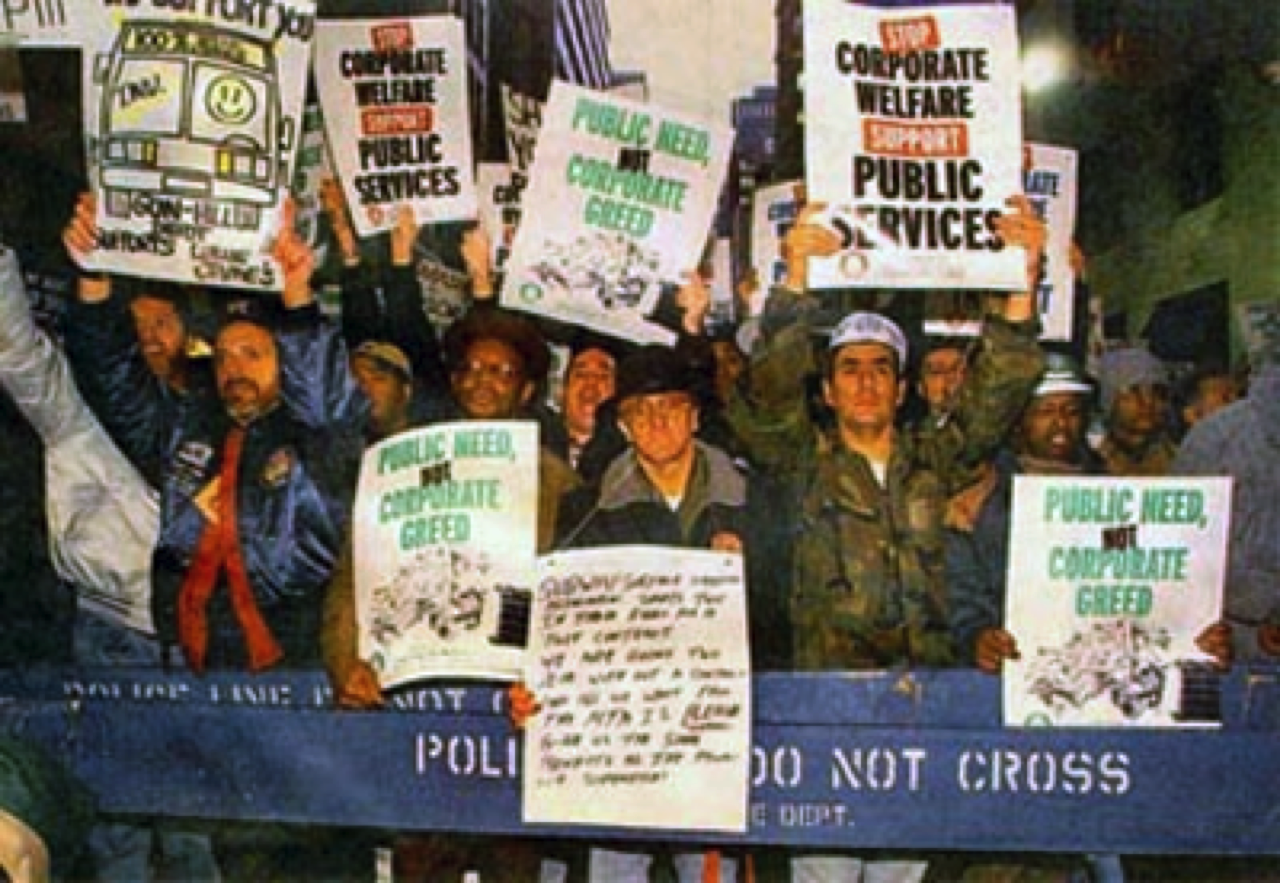
TWU Local 100 Demonstrators
( Michelle V. Agins photo in The New York Times)
On December 14, a letter signed by TWU International President Sonny Hall and Willie James was sent to Local 100 members, informing them that a court-ordered restraining order was served on the local by the New York City Transit Authority (NYCTA) and the Manhattan and Bronx Surface Transit Operating Authority (MaBSTOA), directing members "to continue working and not engage in any strike activity, which includes such things as a work stoppage, a rule book slowdown, a sickout or any concerted attempt to interfere with the normal operation of the transit system. Failure to abide by this order will result in contempt fines leveled against the Union which will quickly bankrupt the Union…" If this wasn't enough of a deterrent, New York's Taylor Law, which prohibits public employee strikes, subjects both the union and its members to extremely harsh penalties including employees' loss of two days pay for each day on strike. The Daily News reported that for the 11-day 1980 strike period, members paid such fines.
Not to be outdone, labor journalist Harry Kelber described how Mayor Giuliani got a judge to issue "one of the most restrictive injunctions ever imposed on any New York City labor dispute." The Giuliani injunction increased the penalty on each striker to $25,000 per day "to be doubled and redoubled for as long as workers remained on strike. The union would be fined one million as a starting penalty, an amount to be redoubled for each day of the strike." Giuliani went on the air to "repeatedly attack the union…" and said that if the union members struck, they would be murderers because "people will die as a result of it."
Pressure on the union's leaders and members was intense. It seemed, for a few days, that the Transit Authority, mayor and governor had gained the upper hand. But CCI provided the union with a big "ace in the hole" and the union was ready to use it! The leadership had authorized a large printing of a new four-page brochure CCI produced, but James instructed Rogers not to release it publicly to anyone! James had copies in hand entering what were the final days of negotiations. The document provided James and the union with the kind of ammunition and muscle that would again turn the tide in the union's favor.
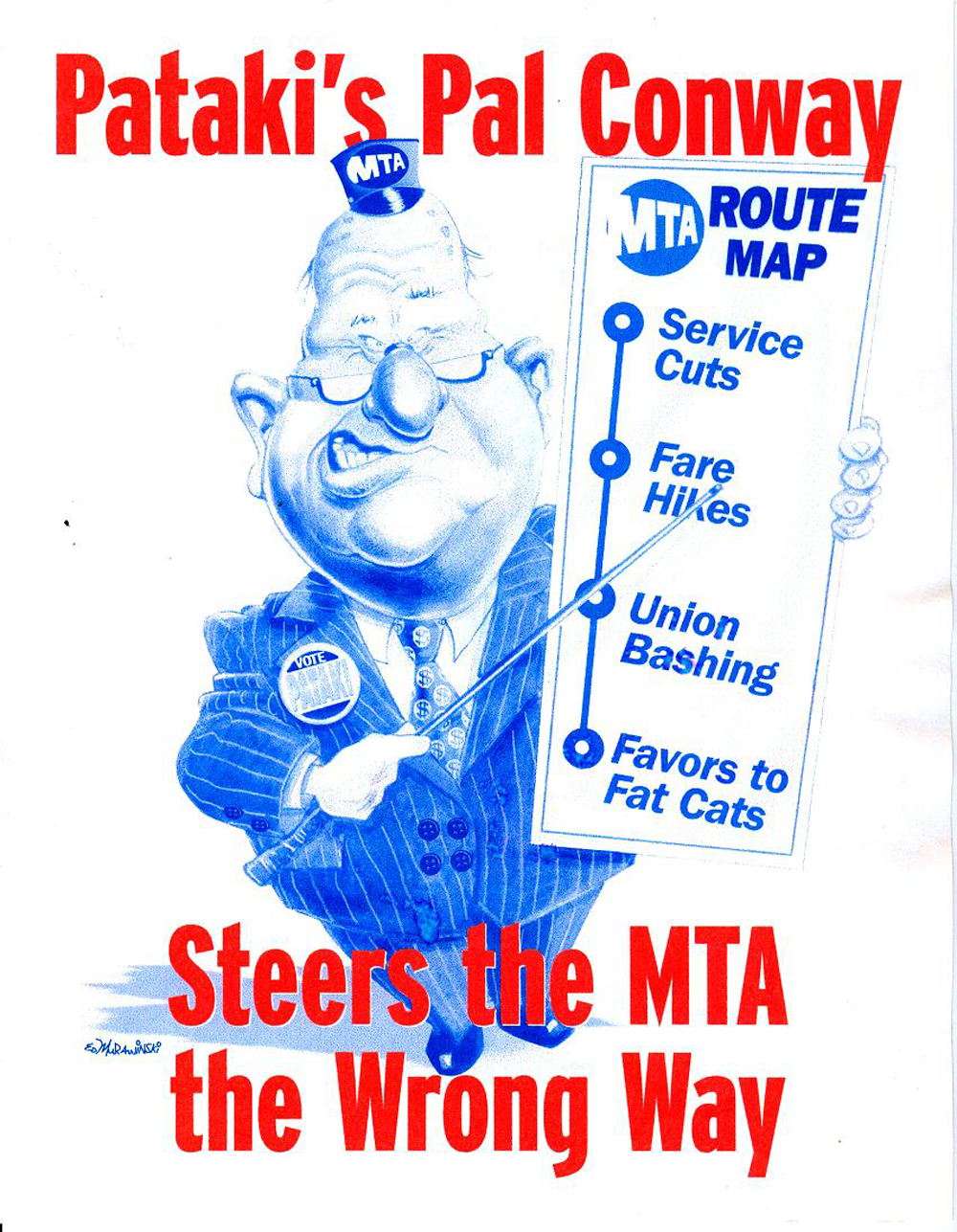
Cover of never released brochure
"Pataki's Pal Conway" produced by CCI
Leading up to the final days of negotiations, Local 100 had shown the MTA, the governor and the mayor that it could communicate with riders and the public in a professional, persuasive and hard-hitting manner. Unless the union got a fair deal instead of a raw deal, as happened with the previous contract, the MTA, governor and mayor could try to deal with the ramifications of explosive information to be released to millions of New Yorkers in the new brochure entitled "Pataki's Pal Conway Steers the MTA the Wrong Way."
This brochure documented the seedy history, past and present of Pataki's appointed MTA Chairman E. Virgil Conway and demanded his resignation. Ray Rogers had effectively dealt with Conway two decades earlier when Conway was on the board of directors of the notorious textile giant, J.P. Stevens & Co., America's number one labor law violator. The brochure highlighted Conway's involvement at J.P. Stevens under the subhead, "He fired 'Norma Rae'." Under the subhead "Big-time bank bungling," it described how The Seamen's Bank for Savings, with Conway as president, chair and CEO, engaged in redlining whereby the bank repeatedly denied loans to residents of lower-income New York City neighborhoods where it operated branches. And it described how, under Conway, the bank became insolvent and its deposits were taken over by Chase Manhattan Bank.
Under the subhead, "A real Con(Ed) job," it described Conway's legacy at the giant utility Consolidated Edison, where he had served on the board for 29 years and in which he owned half a million dollars of stock. It described how Con Ed charges some of the nation's highest utility rates, has one of the worst records of non-compliance with environmental regulators of any utility, has committed hundreds of violations of occupational safety laws, has hostile relations with its workforce, and how it paid millions to settle lawsuits over the release of deadly asbestos into the air, illegal discharging of oil and other contaminants into city waterways, and failing to clean up scores of leaks and spills.
Under the subhead, "Trucking Troubles," it pointed out Conway's role as a board member of Union Pacific Corp., whose main subsidiary, Overnite Transportation, was accused by the National Labor Relations Board and fined $1.6 million for firing and harassing hundreds of workers and denying them pay raises and benefits because they supported the Teamsters Union. "Overnite's unfair labor practices have 'emanated from the highest level of officials,' according to an NLRB decision in November. That certainly includes 'Virge' Conway, whose personal stock holdings in Union Pacific total nearly $1 million," the brochure said.
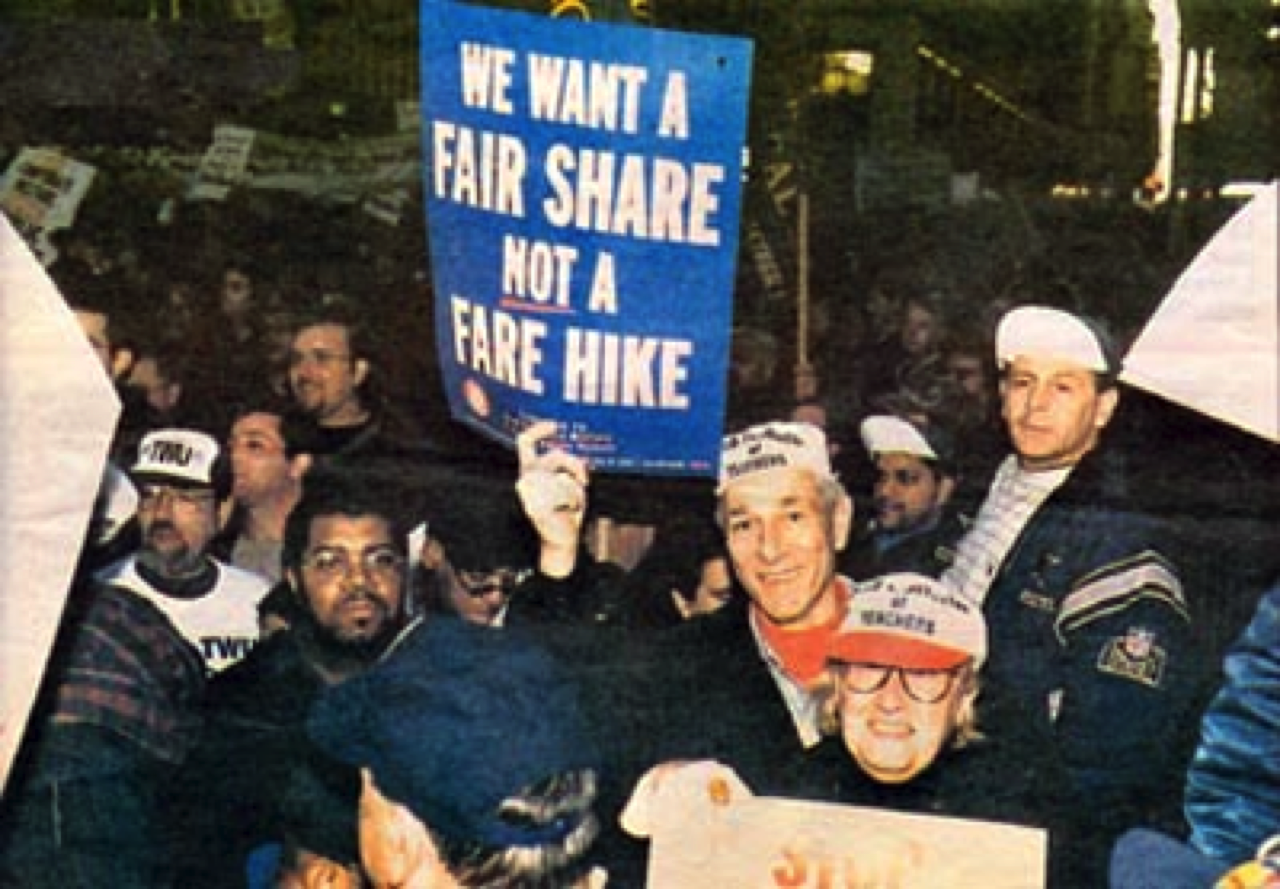
TWU Local 100 protesters
Conway, the brochure added, was also a director and chairman of the executive committee of Trism, Inc., another trucking firm which had recently filed for reorganization under Chapter 11 of the U.S. Bankruptcy Code. The brochure also questioned how much time and energy Conway actually devotes to the MTA considering the many corporate boards on which he serves.
The Conway section concluded:
"As Wayne Barrett wrote in the Village Voice after Conway became MTA chairman, 'Conway's record…paints a portrait of him as an organizational ostrich who will not raise a noticeable objection to patronage, labor, and environmental abuses that would outrage the average subway rider. That, after all, may be what makes him perfect for the Pataki team.' "
Another blockbuster section of the brochure entitled "Your Bus or Train vs. the Gravy Train," included three subheads: "Pols starve public transit;" "Pataki's pork barrel" and "The DA's investigation." A collage of clippings of recent newspaper headlines from the Daily News, New York Post and The New York Times focused on corruption charges and investigations embroiling the state's Empire State Development Corp. (ESDC) and its chairman, Pataki appointee Charles Gargano, described by The New York Observer as "a master of sleazy politics."
In his New York Post op-ed column, "The Workers Won, the Fat Cats Lost" published on December 17, Willie James enumerated the contract gains and added: "Perhaps most significantly, given our members' widespread and well-justified resentment toward management's usual 'guilty until proven innocent' assumptions, we challenged abusive MTA disciplinary procedures and succeeded in changing them in the interest of workplace fairness and justice… Already, Mayor Giuliani is complaining that we won too much and that other public employees dare not expect to make comparable advances."
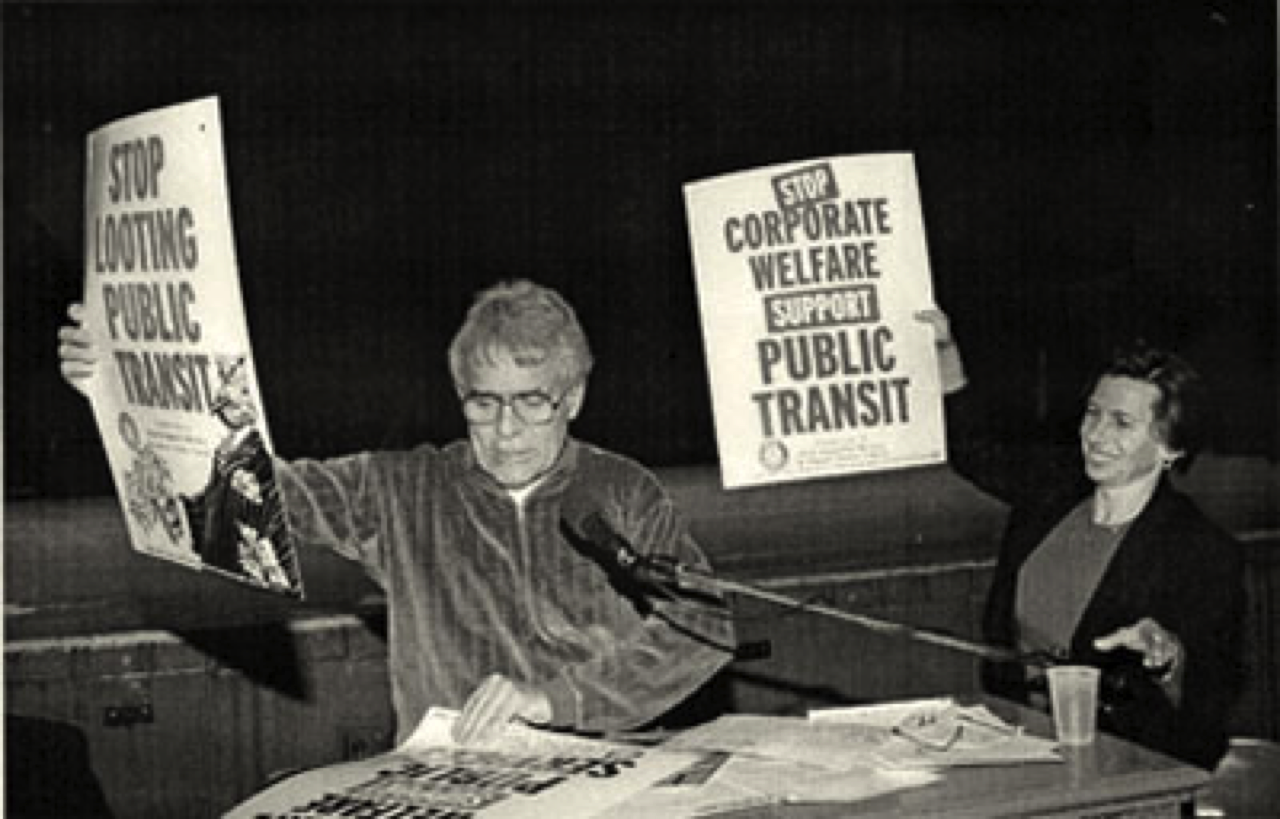
Ray Rogers with United Federation of Teachers President Randi Weingarten rallying support from 1,500 UFT delegates for Local 100's contract campaign
Ray Rogers told Willie James on several occasions that if Local 100 actually contemplated a strike, he would outline a strategy that would completely turn the tables on the MTA, governor and mayor. It would generate national media coverage and win overwhelming support from the public while putting the MTA, mayor and governor in an unprecedented predicament. If union leaders had talked to CCI in 2005, they could have avoided a calamity for themselves and Local 100 in that contract year. As a result of the strike of 2005, Local 100 President Roger Toussaint was sentenced to 10 days in jail, the local was fined $2.5 million and it lost dues checkoff and public sentiment was turned heavily against them.
If transit workers want to maximize their chances of winning, and even if they decide to strike, they must take an entirely different approach given the serious consequences of such a decision. They must think strategically and fight smart, as Local 100 did in 1999.